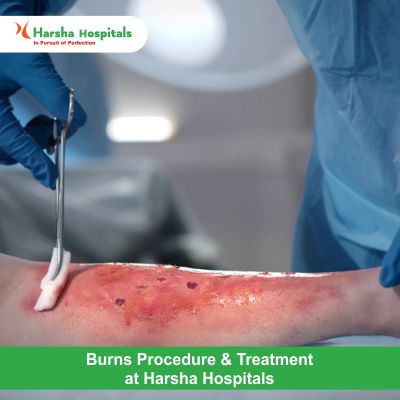Burns Procedure & Treatment at Harsha Hospitals
A burn occurs when skin tissue is damaged by heat, chemicals, electricity, or radiation. The majority of burns are unintentional. Burns come in a variety of degrees A burn that is not treated can get infected.
Every year, about Hundreds of patients visit the emergency room with burn injuries. Accidental burns are very common among children.
Accidental burns can affect anyone, but children, teenagers, and the elderly are the most vulnerable. Cooking-related burns, such as splashing hot water on skin, are more common in this age range. Children and teenagers are also more likely to burn themselves with lighters, matches, and fireworks.
Burns are classified according to their severity by medical professionals. we will assess the extent of the skin injury. The following are the burn degrees:
Burns of the first degree are minor (like most sunburns). The top layer of skin (epidermis) becomes red and unpleasant, but it usually does not blister.

Second-degree burns affect the upper and lower layers of the skin (dermis). Pain, redness, swelling, and blistering are all possible side effects.
Third-degree burns affect the epidermis, dermis, and fat layers of the skin. Hair follicles and sweat glands are also destroyed by the burn. Because third-degree burns injure nerve endings, you will most likely feel pain in the area adjacent to the burn rather than in the burn itself. Burned skin has a leathery appearance and can be black, white, or red.
A burn can be caused by a variety of factors. Burns are most commonly caused by thermal sources such as fire, hot liquids, steam, and contact with hot surfaces. Chemicals, such as cement, acids, or drain cleaners, are among the other culprits, Radiation, Electricity.
The severity or degree of the burn determines the symptoms. Symptoms are frequently worst in the hours or days following a burn. Symptoms of a burn include: Pain, Swelling, Skin that is either white or burned (black), Skin that is peeling.
What is the procedure for determining the severity of burns?
To evaluate the degree or severity of the burn, we shall examine it. This procedure entails calculating the proportion of the body that has been burned as well as the depth of the burn. The burn may be classified as follows by your provider:
Minor: First- and second-degree burns that cover less than 10% of the body are classified as minor and do not usually necessitate hospitalisation.
Moderate burns cover around 10% of the body and are classed as second-degree burns. Moderate to severe burns on the hands, feet, face, or genitals are possible. Severe burns are those that cover more than 1% of the body and are classified as third-degree burns.
Most first- and second-degree burns recover in two to three weeks with proper care. You may have scars depending on the degree of the burn, which will dissipate over time. Physical and occupational therapy are required for those recuperating from third-degree burns in order to maintain joint mobility and enhance function.
Harsha Hospitals is one of Best Hospital For Burns Treatment In Hyderabad. Visit Harsha Hospitals for best and Better Treatment.


